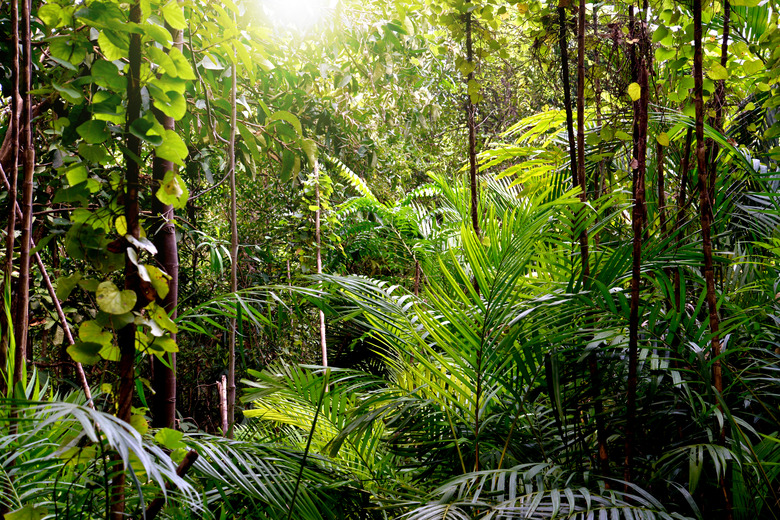What Is The Torrid Zone?
The torrid zone refers to the area of the earth near the equator. As its name suggests, the torrid zone is generally warm. It has a wet and dry season but does not experience the four seasons familiar to residents of the temperate zones further from the equator. The warmth of the torrid zone influences its weather, ecosystems and geographic features.
TL;DR (Too Long; Didn't Read)
The torrid zone refers to the area of the earth between the Tropic of Cancer and the Tropic of Capricorn. Geographically, the torrid zone is defined by 23.5 degrees north latitude and 23.5 degrees south latitude.
History
History
The term torrid zone was first used around 320 B.C.E. by the Greek scientist Aristotle to define the area of the earth closest to the equator. Aristotle presumed this area was too hot for human habitation since the sun's rays targeted this region from directly above. He also proposed a temperate zone with a livable climate and a frigid zone near the Arctic Circle.
Another Greek philosopher named Parmenides also divided these zones into five separate regions with the torrid zone as the base from 23 degrees north and south latitude. A north and south temperate zone were added as were a north and south frigid zone to create a five-zone climate system that remained in use until the standardized Koppen climate mapping system was devised and instituted in the 19th and 20th centuries.
Features
Features
When thinking of the tropics, it's quite typical to think of abundant rainfall, lush plants and trees and varied animal life. The torrid zone contains all of these features and one important event that doesn't occur in the other climate zones: The sun is directly overhead at least once during the year in the torrid zone. The temperature in these tropical zones is warm and humid and generally moist year-round.
However, the torrid zone encompasses a variety of topographic features that affect climate. Consider that many deserts and mountains fall within the latitudes defining the torrid zone. Rainforests might be the more typical presumption for the torrid zone, but even snow-capped mountains are possible within this zone.
The Andes Mountains in Chile and Argentina fall within the tropical zone but contain snow and alpine tundra. Australia and portions of Africa fall within the torrid zone. Both of these continents have large areas of desert with extremely dry year-round conditions.
Ecosystems
Ecosystems
Within the torrid zone exists a multitude of vibrant plant and animal life. Since we now know that the torrid can include both tropical rainforest and arid desert, it's important to look at the ecosystems that have adapted to the climate. These thriving mini-communities are called biomes.
Biomes exist throughout the zones, but some distinctive ones exist in the torrid zone. The tropical rainforest contains a dense tree canopy that blocks most sunlight from the forest floor. However, the smaller trees, shrubs and ferns on the rainforest floor have adapted to the lack of sunlight. In contrast, areas of the Sahara Desert fall within the torrid zone and contain animals and plants that have adapted to the long days of sunlight and little rain.
Weather
Weather
The tropical zone contains areas that are the hottest places on earth. Most have a wet season and a dry season as opposed to the more typical cold and hot seasons of the temperate zones. Most locales within the torrid zone receive plenty of rainfall to promote lush vegetation growth with the aid of the sun directly overhead. The temperature stays relatively uniform from day to night. Cloud cover helps keep the temperature uniform throughout the day and through the seasons.
This very same cloud cover also promotes almost daily rainfall during the wet season. When warm moist air rises and is coupled with ground heating by the sun, this causes atmospheric disturbances resulting in thunderstorms. Prevailing winds in the tropics tend to blow from east to west, often causing deserts to be located on the western side of major continental masses.
Significance
Significance
The torrid zone contains areas of abundant rainfall and heat from the earth's surface. Wrapped around the Equator lie a band of clouds that fuel the weather for the torrid zone. This intertropical convergence zone can bring daily thunderstorms to the torrid zone and controls the weather of this zone. Trade winds from the north moving in a southwesterly direction converge with winds from the southern hemisphere coming from a northwesterly direction to form this band of clouds.
Cite This Article
MLA
Heron, S.F.. "What Is The Torrid Zone?" sciencing.com, https://www.sciencing.com/torrid-zone-5082114/. 24 April 2018.
APA
Heron, S.F.. (2018, April 24). What Is The Torrid Zone?. sciencing.com. Retrieved from https://www.sciencing.com/torrid-zone-5082114/
Chicago
Heron, S.F.. What Is The Torrid Zone? last modified March 24, 2022. https://www.sciencing.com/torrid-zone-5082114/

